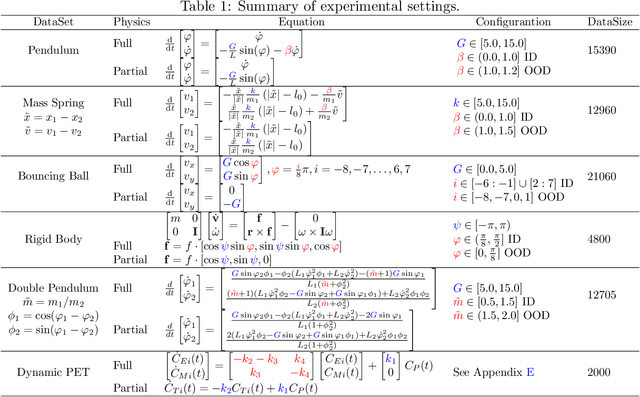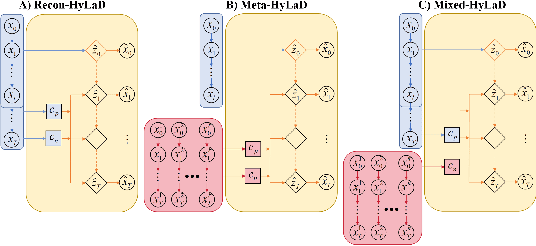Huafeng Liu
Dynamic PET Image Prediction Using a Network Combining Reversible and Irreversible Modules
Oct 30, 2024



Abstract:Dynamic positron emission tomography (PET) images can reveal the distribution of tracers in the organism and the dynamic processes involved in biochemical reactions, and it is widely used in clinical practice. Despite the high effectiveness of dynamic PET imaging in studying the kinetics and metabolic processes of radiotracers. Pro-longed scan times can cause discomfort for both patients and medical personnel. This study proposes a dynamic frame prediction method for dynamic PET imaging, reduc-ing dynamic PET scanning time by applying a multi-module deep learning framework composed of reversible and irreversible modules. The network can predict kinetic parameter images based on the early frames of dynamic PET images, and then generate complete dynamic PET images. In validation experiments with simulated data, our network demonstrated good predictive performance for kinetic parameters and was able to reconstruct high-quality dynamic PET images. Additionally, in clinical data experiments, the network exhibited good generalization performance and attached that the proposed method has promising clinical application prospects.
FashionR2R: Texture-preserving Rendered-to-Real Image Translation with Diffusion Models
Oct 18, 2024Abstract:Modeling and producing lifelike clothed human images has attracted researchers' attention from different areas for decades, with the complexity from highly articulated and structured content. Rendering algorithms decompose and simulate the imaging process of a camera, while are limited by the accuracy of modeled variables and the efficiency of computation. Generative models can produce impressively vivid human images, however still lacking in controllability and editability. This paper studies photorealism enhancement of rendered images, leveraging generative power from diffusion models on the controlled basis of rendering. We introduce a novel framework to translate rendered images into their realistic counterparts, which consists of two stages: Domain Knowledge Injection (DKI) and Realistic Image Generation (RIG). In DKI, we adopt positive (real) domain finetuning and negative (rendered) domain embedding to inject knowledge into a pretrained Text-to-image (T2I) diffusion model. In RIG, we generate the realistic image corresponding to the input rendered image, with a Texture-preserving Attention Control (TAC) to preserve fine-grained clothing textures, exploiting the decoupled features encoded in the UNet structure. Additionally, we introduce SynFashion dataset, featuring high-quality digital clothing images with diverse textures. Extensive experimental results demonstrate the superiority and effectiveness of our method in rendered-to-real image translation.
Deep unrolled primal dual network for TOF-PET list-mode image reconstruction
Oct 15, 2024



Abstract:Time-of-flight (TOF) information provides more accurate location data for annihilation photons, thereby enhancing the quality of PET reconstruction images and reducing noise. List-mode reconstruction has a significant advantage in handling TOF information. However, current advanced TOF PET list-mode reconstruction algorithms still require improvements when dealing with low-count data. Deep learning algorithms have shown promising results in PET image reconstruction. Nevertheless, the incorporation of TOF information poses significant challenges related to the storage space required by deep learning methods, particularly for the advanced deep unrolled methods. In this study, we propose a deep unrolled primal dual network for TOF-PET list-mode reconstruction. The network is unrolled into multiple phases, with each phase comprising a dual network for list-mode domain updates and a primal network for image domain updates. We utilize CUDA for parallel acceleration and computation of the system matrix for TOF list-mode data, and we adopt a dynamic access strategy to mitigate memory consumption. Reconstructed images of different TOF resolutions and different count levels show that the proposed method outperforms the LM-OSEM, LM-EMTV, LM-SPDHG,LM-SPDHG-TV and FastPET method in both visually and quantitative analysis. These results demonstrate the potential application of deep unrolled methods for TOF-PET list-mode data and show better performance than current mainstream TOF-PET list-mode reconstruction algorithms, providing new insights for the application of deep learning methods in TOF list-mode data. The codes for this work are available at https://github.com/RickHH/LMPDnet
Unsupervised Learning of Hybrid Latent Dynamics: A Learn-to-Identify Framework
Mar 13, 2024



Abstract:Modern applications increasingly require unsupervised learning of latent dynamics from high-dimensional time-series. This presents a significant challenge of identifiability: many abstract latent representations may reconstruct observations, yet do they guarantee an adequate identification of the governing dynamics? This paper investigates this challenge from two angles: the use of physics inductive bias specific to the data being modeled, and a learn-to-identify strategy that separates forecasting objectives from the data used for the identification. We combine these two strategies in a novel framework for unsupervised meta-learning of hybrid latent dynamics (Meta-HyLaD) with: 1) a latent dynamic function that hybridize known mathematical expressions of prior physics with neural functions describing its unknown errors, and 2) a meta-learning formulation to learn to separately identify both components of the hybrid dynamics. Through extensive experiments on five physics and one biomedical systems, we provide strong evidence for the benefits of Meta-HyLaD to integrate rich prior knowledge while identifying their gap to observed data.
Hybrid Kinetics Embedding Framework for Dynamic PET Reconstruction
Mar 12, 2024Abstract:In dynamic positron emission tomography (PET) reconstruction, the importance of leveraging the temporal dependence of the data has been well appreciated. Current deep-learning solutions can be categorized in two groups in the way the temporal dynamics is modeled: data-driven approaches use spatiotemporal neural networks to learn the temporal dynamics of tracer kinetics from data, which relies heavily on data supervision; physics-based approaches leverage \textit{a priori} tracer kinetic models to focus on inferring their parameters, which relies heavily on the accuracy of the prior kinetic model. In this paper, we marry the strengths of these two approaches in a hybrid kinetics embedding (HyKE-Net) framework for dynamic PET reconstruction. We first introduce a novel \textit{hybrid} model of tracer kinetics consisting of a physics-based function augmented by a neural component to account for its gap to data-generating tracer kinetics, both identifiable from data. We then embed this hybrid model at the latent space of an encoding-decoding framework to enable both supervised and unsupervised identification of the hybrid kinetics and thereby dynamic PET reconstruction. Through both phantom and real-data experiments, we demonstrate the benefits of HyKE-Net -- especially in unsupervised reconstructions -- over existing physics-based and data-driven baselines as well as its ablated formulations where the embedded tracer kinetics are purely physics-based, purely neural, or hybrid but with a non-adaptable neural component.
VideoMAC: Video Masked Autoencoders Meet ConvNets
Feb 29, 2024Abstract:Recently, the advancement of self-supervised learning techniques, like masked autoencoders (MAE), has greatly influenced visual representation learning for images and videos. Nevertheless, it is worth noting that the predominant approaches in existing masked image / video modeling rely excessively on resource-intensive vision transformers (ViTs) as the feature encoder. In this paper, we propose a new approach termed as \textbf{VideoMAC}, which combines video masked autoencoders with resource-friendly ConvNets. Specifically, VideoMAC employs symmetric masking on randomly sampled pairs of video frames. To prevent the issue of mask pattern dissipation, we utilize ConvNets which are implemented with sparse convolutional operators as encoders. Simultaneously, we present a simple yet effective masked video modeling (MVM) approach, a dual encoder architecture comprising an online encoder and an exponential moving average target encoder, aimed to facilitate inter-frame reconstruction consistency in videos. Additionally, we demonstrate that VideoMAC, empowering classical (ResNet) / modern (ConvNeXt) convolutional encoders to harness the benefits of MVM, outperforms ViT-based approaches on downstream tasks, including video object segmentation (+\textbf{5.2\%} / \textbf{6.4\%} $\mathcal{J}\&\mathcal{F}$), body part propagation (+\textbf{6.3\%} / \textbf{3.1\%} mIoU), and human pose tracking (+\textbf{10.2\%} / \textbf{11.1\%} PCK@0.1).
Learning with Imbalanced Noisy Data by Preventing Bias in Sample Selection
Feb 17, 2024Abstract:Learning with noisy labels has gained increasing attention because the inevitable imperfect labels in real-world scenarios can substantially hurt the deep model performance. Recent studies tend to regard low-loss samples as clean ones and discard high-loss ones to alleviate the negative impact of noisy labels. However, real-world datasets contain not only noisy labels but also class imbalance. The imbalance issue is prone to causing failure in the loss-based sample selection since the under-learning of tail classes also leans to produce high losses. To this end, we propose a simple yet effective method to address noisy labels in imbalanced datasets. Specifically, we propose Class-Balance-based sample Selection (CBS) to prevent the tail class samples from being neglected during training. We propose Confidence-based Sample Augmentation (CSA) for the chosen clean samples to enhance their reliability in the training process. To exploit selected noisy samples, we resort to prediction history to rectify labels of noisy samples. Moreover, we introduce the Average Confidence Margin (ACM) metric to measure the quality of corrected labels by leveraging the model's evolving training dynamics, thereby ensuring that low-quality corrected noisy samples are appropriately masked out. Lastly, consistency regularization is imposed on filtered label-corrected noisy samples to boost model performance. Comprehensive experimental results on synthetic and real-world datasets demonstrate the effectiveness and superiority of our proposed method, especially in imbalanced scenarios. Comprehensive experimental results on synthetic and real-world datasets demonstrate the effectiveness and superiority of our proposed method, especially in imbalanced scenarios.
Is ChatGPT A Good Keyphrase Generator? A Preliminary Study
Mar 23, 2023Abstract:The emergence of ChatGPT has recently garnered significant attention from the computational linguistics community. To demonstrate its capabilities as a keyphrase generator, we conduct a preliminary evaluation of ChatGPT for the keyphrase generation task. We evaluate its performance in various aspects, including keyphrase generation prompts, keyphrase generation diversity, multi-domain keyphrase generation, and long document understanding. Our evaluation is based on six benchmark datasets, and we adopt the prompt suggested by OpenAI while extending it to six candidate prompts. We find that ChatGPT performs exceptionally well on all six candidate prompts, with minor performance differences observed across the datasets. Based on our findings, we conclude that ChatGPT has great potential for keyphrase generation. Moreover, we discover that ChatGPT still faces challenges when it comes to generating absent keyphrases. Meanwhile, in the final section, we also present some limitations and future expansions of this report.
DULDA: Dual-domain Unsupervised Learned Descent Algorithm for PET image reconstruction
Mar 10, 2023Abstract:Deep learning based PET image reconstruction methods have achieved promising results recently. However, most of these methods follow a supervised learning paradigm, which rely heavily on the availability of high-quality training labels. In particular, the long scanning time required and high radiation exposure associated with PET scans make obtaining this labels impractical. In this paper, we propose a dual-domain unsupervised PET image reconstruction method based on learned decent algorithm, which reconstructs high-quality PET images from sinograms without the need for image labels. Specifically, we unroll the proximal gradient method with a learnable l2,1 norm for PET image reconstruction problem. The training is unsupervised, using measurement domain loss based on deep image prior as well as image domain loss based on rotation equivariance property. The experimental results domonstrate the superior performance of proposed method compared with maximum likelihood expectation maximazation (MLEM), total-variation regularized EM (EM-TV) and deep image prior based method (DIP).
STPDnet: Spatial-temporal convolutional primal dual network for dynamic PET image reconstruction
Mar 08, 2023Abstract:Dynamic positron emission tomography (dPET) image reconstruction is extremely challenging due to the limited counts received in individual frame. In this paper, we propose a spatial-temporal convolutional primal dual network (STPDnet) for dynamic PET image reconstruction. Both spatial and temporal correlations are encoded by 3D convolution operators. The physical projection of PET is embedded in the iterative learning process of the network, which provides the physical constraints and enhances interpretability. The experiments of real rat scan data have shown that the proposed method can achieve substantial noise reduction in both temporal and spatial domains and outperform the maximum likelihood expectation maximization (MLEM), spatial-temporal kernel method (KEM-ST), DeepPET and Learned Primal Dual (LPD).
 Add to Chrome
Add to Chrome Add to Firefox
Add to Firefox Add to Edge
Add to Edge